The contribution and the importance of modern ultrasound techniques in the diagnosis of major structural abnormalities in the first trimester - case reports
- PMID: 24778838
- PMCID: PMC3945260
The contribution and the importance of modern ultrasound techniques in the diagnosis of major structural abnormalities in the first trimester - case reports
Abstract
We describe a series of cases where modern ultrasound (US) techniques diagnosed major structural abnormalities of the fetus in the first trimester (FT), unapparent when using the basic protocol of US investigation. In some cases, major structural abnormalities can be revealed in the FT scan solely to specialized personnel. Perhaps early screening should be confined in specialized centers, because congenital abnormalities detailed diagnostic has a huge impact in counseling the couple and also in prenatal advice of future pregnancies.
Keywords: First Trimester; Structural Abnormalities; Ultrasound.
Figures

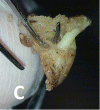






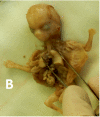

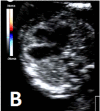

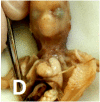
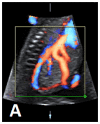



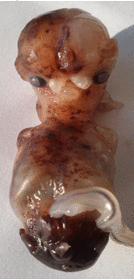

Similar articles
-
Improved detection rate of structural abnormalities in the first trimester using an extended examination protocol.Ultrasound Obstet Gynecol. 2013 Sep;42(3):300-9. doi: 10.1002/uog.12489. Ultrasound Obstet Gynecol. 2013. PMID: 23595897
-
[Prospective cohort study of fetal nuchal translucency in first-trimester and pregnancy outcome].Zhonghua Fu Chan Ke Za Zhi. 2020 Feb 25;55(2):94-99. doi: 10.3760/cma.j.issn.0529-567X.2020.02.007. Zhonghua Fu Chan Ke Za Zhi. 2020. PMID: 32146737 Chinese.
-
Detection of structural abnormalities in the first trimester using ultrasound.Best Pract Res Clin Obstet Gynaecol. 2014 Apr;28(3):341-53. doi: 10.1016/j.bpobgyn.2013.11.004. Epub 2013 Dec 4. Best Pract Res Clin Obstet Gynaecol. 2014. PMID: 24355991 Review.
-
Diagnosis of fetal non-chromosomal abnormalities on routine ultrasound examination at 11-13 weeks' gestation.Ultrasound Obstet Gynecol. 2019 Oct;54(4):468-476. doi: 10.1002/uog.20844. Ultrasound Obstet Gynecol. 2019. PMID: 31408229
-
Evaluation of prenatally diagnosed structural congenital anomalies.J Obstet Gynaecol Can. 2009 Sep;31(9):875-881. doi: 10.1016/S1701-2163(16)34307-9. J Obstet Gynaecol Can. 2009. PMID: 19941713 Review. English, French.
Cited by
-
Importance of Follow-Up and Early Detailed Evaluation in Early Onset Growth Restricted Fetuses.Curr Health Sci J. 2019 Jul-Sep;45(3):333-338. doi: 10.12865/CHSJ.45.03.14. Epub 2019 Sep 30. Curr Health Sci J. 2019. PMID: 32042464 Free PMC article.
-
Prenatal findings and pregnancy outcome in fetuses with right and double aortic arch. A 10-year experience at a tertiary center.Rom J Morphol Embryol. 2020 Oct-Dec;61(4):1173-1184. doi: 10.47162/RJME.61.4.19. Rom J Morphol Embryol. 2020. PMID: 34171066 Free PMC article.
References
-
- Filly R.A., Crane J.P. Routine Obstetric Sonography. J Ultrasound Med. 2002 Jul;21(7):713–718. - PubMed
-
- Achiron R, Tadmor O. Screening for fetal anomalies during the first trimester of pregnancy: transvaginal versus transabdominal sonography. Ultrasound Obstet Gynecol. 1991;1:186–191. - PubMed
-
- Hernadi L, Torocsik M. Screening for fetal anomalies in the 12th week of pregnancy by transvaginal sonography in an unselected population. Prenat Diagn. 1997;17:753–759. - PubMed
-
- Hafner E, Schuchter K, Liebhart E, Philipp K. Results of routine fetal nuchal translucency measurement at weeks 10-13 in 4233 unselected pregnant women. Prenat Diagn. 1998;18:29–34. - PubMed
-
- D’Ottavio G, Mandruzzato G, Meir YJ, Rustico MA, Fischer-Tamaro L, Conoscenti G. Comparison of first trimester and second trimester screening for fetal anomalies. Ann NY Acad Sci. 1998;847:200–209. - PubMed
Publication types
LinkOut - more resources
Full Text Sources
